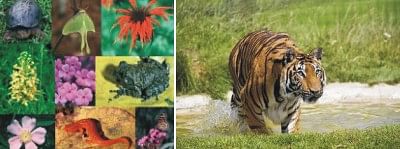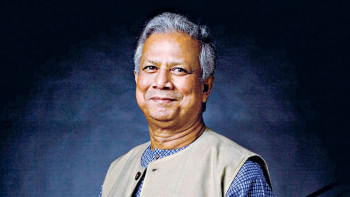Conserving biodiversity must for survival

Biodiversity loss is one of the environmental issues of concern more or less across the whole world. Bangladesh is rich in both floral and faunal diversities evident in a varied range of ecosystems starting from the northern and eastern hills to the southern seas. The all-around environmental condition of Bangladesh is highly conducive to a biodiversity wax. She has 113 species of mammals; 628 species of birds; 126 species of reptiles; 22 species of amphibians; 708 species of fishes (fresh and marine); 400 species of mollusks; 5000 species of vascular plants (A. Nishat, 2007).
Biodiversity and economy: Biodiversity is the natural power-house of planetary health of the Earth. The rich biodiversity in Bangladesh contributes significantly to the country's economy and the diversified livelihood sources of her people. The people of Bangladesh depend on biodiversity for their day to day sustenance as well as overall livelihood security. For example, over 60 million people are dependent on aquatic resources everyday. One million are full-time fisher folk and 11 million have taken to part-time fishing in the country. Consumption of fish meets 50% to 65% of the country's protein requirement. The fisheries sector contributes about 3.3% of the total export revenue and employs 5% of the country's total workforce (Parveen and Faisal, 2001). The agriculture sector provides 63.5% of the country's employment and contributes 24% of the GDP (BBS, 2002). The Sundarbans alone provides livelihood and employment to an estimated 112,000 people (Khan, 2001).
Extinction and endangered level: The over-extraction of resources for livelihood sustenance along with the development initiatives without considering the issue of eco-balance has caused a great depletion of biodiversity in the country. Over the last 100 years, Bangladesh has lost about 10% of its mammalian fauna, 3% avifauna and 4% reptile species. IUCN Bangladesh has identified 58 species of fish, 8 species of amphibians, 63 species of reptiles, 47 species of birds and 43 species of mammals in the country threatened under degrees of risk of extinction. Altogether 327 species of vertebrates are currently categorized as data deficient. On the other hand, Khan et al. (2001) have listed 106 species of plants as endangered including 2-3 species of ferns, 4 species of gymnosperms and the rest, angiosperms. Besides, around 100 of the estimated 6000 vascular plant species in Bangladesh have been listed as threatened to date. Many others, specially the medicinal plant species are facing great pressure.
Threats: Over the years, Bangladesh has experienced a number of threats to her biodiversity. The major threats include loss of habitat, over harvesting of resources and natural calamities etc. Loss of habitat is caused by deforestation (mainly for agricultural expansion and human settlement), urbanization, filling of water bodies, destruction of fish breeding areas (mainly by emitting pollutants), hill slope cultivation and associated silting of water bodies, clear felling for plantation, slash and burn cultivation, forest fire, alien and invasive species, withdrawal of water upstream and salinity intrusion downstream. Besides, pollution of Bangladesh's soil, air and water due to unplanned urbanization and industrialization without considering environmental issues has intensified over the last two decades and constitutes a significant threat to its biological diversity.
Future of biodiversity: In the year 2020, the estimated population of Bangladesh will be 170 million and population density, 1118 persons per sq. km. At present the land resources for agriculture renders a per capita figure of 13 persons per hectare. With the population reaching 170 million by 2020, this figure will increase to 20 persons per hectare. The pressure of the rising number of people on finite amounts of land, water and other natural resources has already resulted in extensive deforestation (a drastic reduction from 10 to 6 percent in forest cover). If the current two percent per year deforestation rate is not reversed at all, the country's forests will probably disappear totally by 2020, and that will evanesce the country's old heritage of biodiversity (The World Bank and BCAS, 1998).
Major initiatives taken: Bangladesh became a signatory to the CBD in 1992 and ratified it in 1994 with its Ministry of Environment and Forest (MoEF) acting as the country focal point. Major commitment of the contracting parties to the CBD included its implementation through the preparation of respective National Biodiversity Strategy and Action Plan (NBSAP). The MoEF prepared the NBSAP for Bangladesh opportunely in 2006 with the technical assistance of the IUCN Bangladesh Country Office and the financial support of the Global Environmental Facility (GEF) through UNDP.
The NBSAP of Bangladesh is a national framework with 6 well-defined objectives, 16 strategies and necessary action plans for the conservation, sustainable use and equitable sharing of benefits of biodiversity. Bangladesh has taken different initiatives and formulated policies although on small scale. Two policy instruments in particular are of major and very direct relevance to biodiversity conservation. These include Bangladesh National Conservation Strategy (NCS) and National Environmental Management Action Plan (NEMAP).
IUCN Bangladesh Country Office has published Red Data Book for the identification and monitoring of endangered and extinct plants and animals. For in situ conservation, about eight large and biologically important ecosystems have been declared as Ecologically Critical Areas (ECAs). For ex-situ conservation of biodiversity, gene bank facility exists. To ensure sustainable use of biodiversity, Bangladesh has, however, taken some programmes including SEMP (Sustainable Environment Management Programme), 4th Fisheries, NCSIP (National Conservation Strategy Implementation Phase) etc. since1995. EIA (Environmental Impact Assessment) for each and every development initiative has been made mandatory. Ministry of Science and Technology (MoST) has recently drafted biosafety rules. But efforts are yet to be taken for access to genetic resources.
Limitations and suggestions: Succinctly speaking, Bangladesh now has momentous amount of laws and projects even at the grassroots level to conserve biodiversity. What is urgent is to ensure firm application of the exiting laws and implementation of the ongoing projects and programmes. However, the following suggested actions may be taken into account in this respect.
*Well defined implementation mechanisms, financing and communication strategies are particularly important for the implementation of NBSAP.
*Biodiversity conservation is a multidisciplinary issue and accordingly needs integrated approach. So, it is exigent to seek the ways and means of integrating the relevant sectoral plans and policies.
*Awareness building and information dissemination should be executed among those responsible, especially among the local people, about biodiversity and the importance of its conservation through advertisement in mass media, documentary film shows and other means of propaganda and motivation.
*Many species are disappearing even before they are identified and registered. Scanty information is available, mostly in scattered literature. So a scientific campaign should immediately be launched with a view to identifying and enlisting all the species of organisms for appropriate stewardship in a planned way.
* The involvement of community members in biodiversity conservation project is a demand of the day. Otherwise, it is quite impossible to fulfil the mission of biodiversity conservation. For instance, Sonadia Island was declared as an Environmentally Critical Area (ECA) in 1999. Nonetheless, many rare species are on the verge of extinction there due to the land grabbing operation undertaken by the community members especially by the local influentials (The Daily Star, June 21, 2008).
*The ultimate target should be to reduce the threats or factors that are detrimental to biodiversity.
Concluding remarks: To sum up, it can be said that Bangladesh is fortunate enough to have rich biodiversity. It enormously contributes to her economic, social and environmental development and to the maintenance of ecological balance. But it is we who are whimsically destroying the habitats of organisms, the biological resource base. In the process we are exerting threats to the sustainability of our own livelihood, economy, and social peace and harmony by insinuation. In Bangladesh, more than most other countries, biodiversity conservation is closely interwoven with social, economic and environmental development. Not only the government but also every individual must work in this mission for well-being of the present and future generation.

 For all latest news, follow The Daily Star's Google News channel.
For all latest news, follow The Daily Star's Google News channel. 



Comments